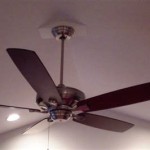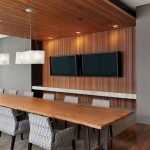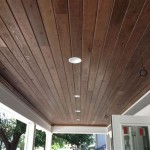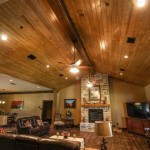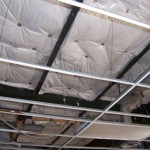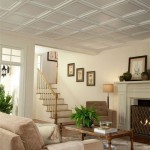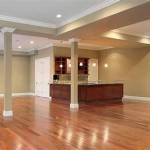What Is Beadboard Ceiling?
Beadboard ceilings, a popular design choice in both residential and commercial spaces, offer a distinctive aesthetic and practical benefits. This ceiling treatment, characterized by its narrow, vertical planks separated by rounded grooves or "beads," brings texture, visual interest, and a touch of traditional charm to any room. Understanding the composition, installation, and specific characteristics of beadboard ceilings is crucial for homeowners and designers considering this option.
The term "beadboard" itself refers to the type of paneling used. This paneling consists of individual, tongue-and-groove planks fitted together to create a continuous surface. The defining feature, the "bead," is a small, rounded detail milled into the edge of each plank, resulting in a series of parallel lines that add depth and shadow. Beadboard can be manufactured from various materials, affecting its durability, cost, and suitability for different environments.
Primarily, beadboard ceilings are selected for their aesthetic appeal. They complement a range of architectural styles, from classic farmhouse to coastal cottage and even some modern interpretations. The texture adds a dimension that is often lacking in plain drywall ceilings, creating a more inviting and visually engaging space. Furthermore, beadboard can be painted in virtually any color, allowing it to blend seamlessly with existing décor or to serve as a focal point.
Beyond aesthetics, beadboard ceilings can also offer practical benefits. They can assist in concealing minor imperfections in the existing ceiling, such as cracks or uneven surfaces, without requiring extensive repairs. In some cases, beadboard can also contribute to sound dampening, although its acoustic properties are limited compared to dedicated soundproofing materials.
Composition and Materials of Beadboard
The composition of beadboard directly influences its performance and application. Several materials are commonly used in its manufacture, each possessing unique advantages and disadvantages.
Wood: Traditional beadboard is crafted from solid wood, typically pine, poplar, or cedar. Wood offers a natural warmth and beauty that is difficult to replicate with other materials. It can be stained or painted to achieve a desired finish. However, wood is susceptible to moisture damage, making it less suitable for bathrooms or kitchens without proper sealing and ventilation. Solid wood beadboard is also generally more expensive than other options.
Medium-Density Fiberboard (MDF): MDF is an engineered wood product made from wood fibers bonded together with resin. It provides a smooth, consistent surface that is ideal for painting. MDF beadboard is less prone to warping and cracking than solid wood and is typically more affordable. However, MDF is highly absorbent and can swell or disintegrate if exposed to moisture. It is also heavier than wood, which can complicate installation.
Polyvinyl Chloride (PVC): PVC beadboard is a plastic-based option that is completely waterproof, making it ideal for bathrooms, kitchens, and other areas prone to moisture. It is resistant to mold, mildew, and insects. PVC beadboard is lightweight and easy to install. While available in various colors, painting PVC can be challenging and may require specialized primers and paints. The aesthetic appeal of PVC may also be considered less authentic than that of wood or MDF.
Other Materials: Beadboard is also available in other composite materials, each offering a unique balance of properties. These options often aim to combine the durability of synthetics with the aesthetic appeal of natural wood. These materials may include wood-plastic composites or other treated options.
Installation Methods for Beadboard Ceilings
The installation process for beadboard ceilings varies depending on the material and the existing ceiling structure. Careful planning and preparation are essential for a successful outcome.
Direct Application: In some cases, beadboard can be directly applied to the existing ceiling if the surface is smooth, level, and structurally sound. This method typically involves using construction adhesive and finishing nails to secure the beadboard planks to the ceiling joists or drywall. It's important to locate the joists accurately and use appropriate fasteners to ensure a secure attachment. This method is best suited for rooms with minimal imperfections in the existing ceiling.
Furring Strips: If the existing ceiling is uneven or damaged, or if additional insulation is desired, furring strips can be installed first. Furring strips are thin strips of wood or metal that are attached to the ceiling joists, creating a level surface for the beadboard. This method allows for minor adjustments to correct imperfections and provides a cavity for insulation or wiring. The beadboard is then attached to the furring strips using nails or screws.
Suspended Ceiling Grid: Another option, particularly in commercial settings, is to install the beadboard within a suspended ceiling grid. This method involves attaching the beadboard panels to standard ceiling tiles or specially designed panels that fit into the grid. This provides easy access to the space above the ceiling for maintenance or repairs. The suspended ceiling grid method can be advantageous for large areas or where access to utilities above the ceiling is required.
Considerations During Installation: Regardless of the chosen method, several factors must be considered during installation. Proper ventilation is crucial, especially in areas prone to moisture. Adequate expansion gaps should be left around the perimeter of the room to accommodate changes in temperature and humidity. Cutting the beadboard planks accurately is essential for a seamless and professional-looking finish. Furthermore, proper safety precautions should be observed, including wearing safety glasses and gloves, and using appropriate tools and equipment.
Aesthetic and Functional Considerations of Beadboard Ceilings
Beyond the technical aspects of material and installation, several aesthetic and functional considerations influence the suitability of beadboard ceilings for different applications.
Architectural Style: Beadboard ceilings are particularly well-suited for architectural styles that emphasize traditional charm and character. They complement farmhouse, cottage, and coastal designs, adding a touch of rustic elegance. However, beadboard can also be incorporated into more contemporary spaces by selecting a neutral color palette and simplifying the overall design.
Room Size and Height: The visual impact of beadboard ceilings can vary depending on the size and height of the room. In smaller rooms, the vertical lines of the beadboard can make the ceiling appear lower. Conversely, in larger rooms, the texture can add visual interest and prevent the ceiling from feeling too expansive. The color of the beadboard also plays a role; lighter colors can help to brighten a small room, while darker colors can create a more intimate atmosphere.
Lighting: The type of lighting used in conjunction with a beadboard ceiling can significantly affect the overall ambiance. Recessed lighting can provide general illumination without detracting from the ceiling's texture. Pendant lights or chandeliers can add a decorative touch and create focal points. Sconces or wall-mounted lights can also be used to highlight the beadboard's details. The placement and intensity of the lighting should be carefully considered to achieve the desired effect.
Maintenance: Maintenance requirements for beadboard ceilings vary depending on the material used. Wood beadboard requires regular cleaning and may need to be refinished periodically to maintain its appearance. MDF beadboard should be protected from moisture and cleaned with a damp cloth. PVC beadboard is the easiest to maintain and can be cleaned with common household cleaners. Regular inspection for signs of damage, such as cracks or warping, is essential to ensure the longevity of the ceiling.
Cost: The cost of beadboard ceilings can vary significantly depending on the material, installation method, and size of the room. Solid wood beadboard is typically the most expensive option, while PVC beadboard is the most affordable. Installation costs can also vary depending on the complexity of the project and the skill of the installer. Obtaining multiple quotes from qualified contractors is recommended to ensure a competitive price.
In summary, beadboard ceilings offer a versatile and attractive option for enhancing the aesthetic appeal and functionality of various spaces. By carefully considering the material, installation method, and design implications, homeowners and designers can create a stunning and enduring ceiling treatment that complements their overall vision.

Beadboard Ceiling Panels Ceilings Armstrong Residential

How To Install A Beadboard Ceiling Pine And Prospect Home

9 Beadboard Ceiling Design Ideas Allura Usa

How To Install A Beadboard Ceiling Pine And Prospect Home

Diy Beadboard Ceiling Tutorial Easy And Inexpensive Custom Treatment

Beadboard Ceiling Panels Ceilings Armstrong Residential

Diy Beadboard Ceiling Tutorial Easy And Inexpensive Custom Treatment

Beadboard Ceiling What It Is And How To Install Yourself

How To Install Beadboard Panels On A Ceiling And Why We Ll Never Do It Again The Lake Land

Diy Beadboard Ceiling Tutorial Easy And Inexpensive Custom Treatment
Related Posts

